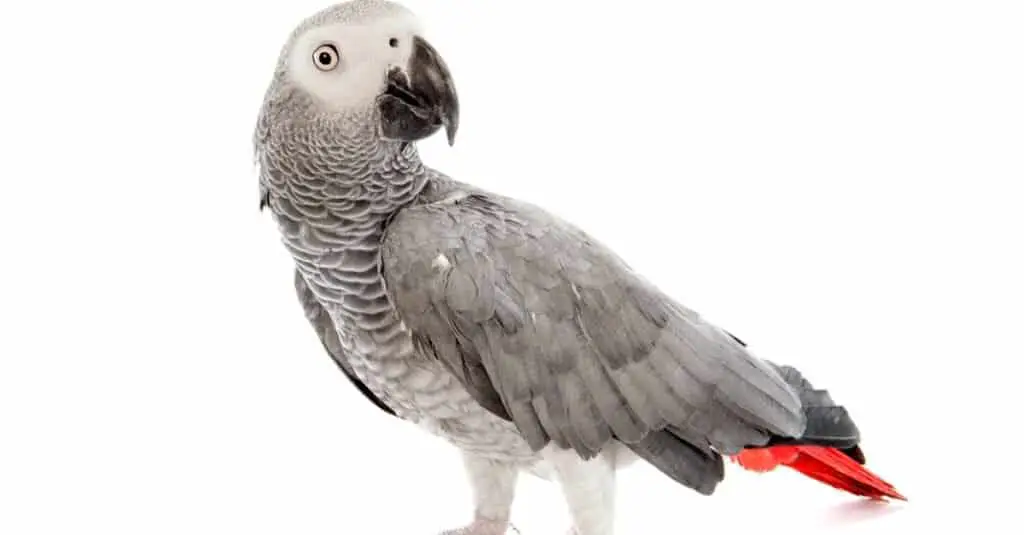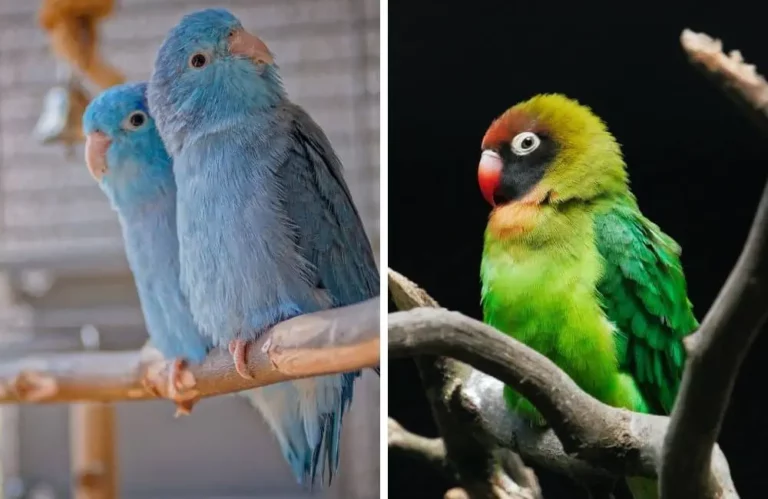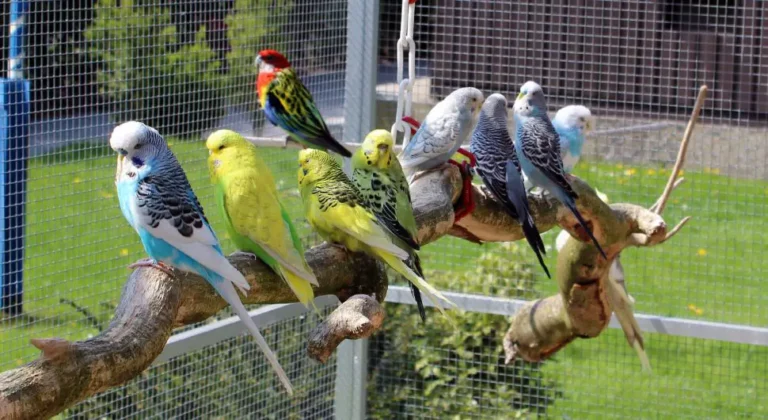Congo vs Timneh African Greys: What’s the Difference?
In the fascinating world of avian pets, Congo African Greys (CAG) and Timneh African Greys (TAG) stand out as two remarkable and highly sought-after subspecies of the African Grey Parrots.
Recognized for their intelligence, longevity, and intriguing personalities, both parrots offer unique experiences for bird enthusiasts. However, understanding the differences between these two subspecies is crucial for potential owners to make an informed decision.
Key Takeaways
- Both CAG and TAG belong to the African Grey Parrots species, known for their intelligence and long lifespan.
- There are physical, behavioral, and care requirements that differentiate these two subspecies.
- Understanding these differences helps potential owners to select the right bird that aligns with their lifestyle and environment.
Short Answer
The main differences between CAG and TAG involve their physical appearance, lifespan, health concerns, temperament, and care needs. CAGs are larger with bright red tails, while TAGs are slightly smaller with maroon tails. Both birds have similar lifespans but may have different health concerns. Behaviorally, CAGs are often described as more reserved than TAGs. Finally, each bird has unique care needs, making it important for potential owners to understand these differences before choosing their feathery friend.
The African Grey Parrots: A Brief Overview
African Grey Parrots hold a special place in the hearts of bird enthusiasts, widely admired for their intelligence and remarkable mimicry abilities. These birds are native to the rainforests of West and Central Africa, where they live in flocks and form strong social bonds.
Notably, African Greys are known for their exceptional longevity, with many living up to 50 years or more in captivity.
These parrots are characterized by their distinctive grey feathers and bright red tails, which have earned them the moniker ‘Grey Parrots.’ Their high intelligence is often compared to that of a young child, with some studies showing that they can perform tasks equivalent to a 4-6-year-old human.
African Greys also have an exceptional ability to mimic human speech and a wide array of sounds, making them one of the most ‘talkative’ pet birds.
When it comes to African Greys, potential owners often find themselves choosing between two distinct subspecies: Congo African Greys (CAG) and Timneh African Greys (TAG).
Although they share many similarities, these subspecies are set apart by a range of physical, behavioral, and care-related differences that can significantly impact the bird-owning experience.
Unveiling the Congo African Grey (CAG) and Timneh African Grey (TAG)

Let’s take a closer look at the two subspecies that often leave potential African Grey owners with a challenging choice.
On one hand, we have the Congo African Grey (CAG), also known as the larger African Grey. Native to various regions in Africa, including the Democratic Republic of Congo, Ivory Coast, and Ghana, CAGs are known for their impressive size, bright red tails, and distinctive silvery-grey plumage.
They can grow up to 12-14 inches long, making them one of the larger pet parrots available.
On the other hand, we find the Timneh African Grey (TAG), the slightly smaller counterpart. TAGs are native to the western parts of Africa, specifically Sierra Leone, Guinea, and Liberia. With a size that usually maxes out at 12 inches, these birds are somewhat smaller than CAGs.
TAGs also display a darker charcoal grey plumage and a maroon tail, distinct features that set them apart from their larger cousins.
Both of these African Grey subspecies are admired for their intelligence and talking abilities, making them a rewarding, albeit challenging choice for potential bird owners. The next sections delve deeper into the unique characteristics and differences that make each of these birds a distinctive pet choice.
Physical Differences between CAG and TAG
When distinguishing between Congo African Greys (CAG) and Timneh African Greys (TAG), one of the first things to note is their physical differences. While both birds share the classic grey plumage, their size, color variations, and certain features help set them apart.
Size and Weight: CAGs are generally larger, with a length ranging between 12-14 inches and an average weight of 400-600 grams. In contrast, TAGs are slightly smaller, typically reaching a length of up to 12 inches and weighing between 275-375 grams.
Color and Feather Patterns: Both subspecies share a predominantly grey plumage, but their tail and beak colors differentiate them. CAGs have bright, cherry red tails and black beaks, while TAGs boast a darker maroon tail and a two-tone beak – the upper mandible being bone-colored with a darker tip.
Eyes: A subtle yet interesting difference lies in their eyes. Young CAGs have dark eyes that lighten to a pale yellow as they age. TAGs, however, start with dark eyes that gradually change to a light grey or beige with age.
Understanding these physical differences can be crucial, especially for potential owners who have a preference for a specific look or size in their prospective pet. However, these birds’ appeal goes beyond their physical appearance, as we’ll see in the following sections.
Lifespan and Health Differences
The Congo African Grey (CAG) and Timneh African Grey (TAG) are long-lived parrots, often living up to 50 years or more in captivity with the right care. However, they can exhibit different susceptibilities to certain health issues.
Lifespan: Both CAGs and TAGs can live for many decades, with life expectancy generally ranging from 40 to 60 years. However, individual birds’ health, diet, and environmental factors can significantly influence this.
Health Issues: While both subspecies are relatively hardy, they can be susceptible to different health issues. For instance, CAGs are more likely to develop feather-picking behaviors, a stress-related condition that can lead to severe feather loss.
They can also be prone to calcium deficiencies and obesity if their diet isn’t appropriately balanced. TAGs, while less likely to feather pick, are also susceptible to calcium deficiencies, as well as respiratory issues if not maintained in a clean and well-ventilated environment.
Mental Health: African Greys, in general, require mental stimulation to remain healthy. They can develop signs of depression, stress, or anxiety if not provided with enough interaction or enrichment.
However, it’s observed that CAGs may be more prone to these issues than TAGs, necessitating a deeper commitment to their mental well-being.
It’s crucial to consult with a vet specializing in avian health for routine check-ups and immediate care at any sign of illness. The next sections delve into the behavioral differences and specific care needs of these two remarkable bird species.
Behavioral Differences: Personality and Intelligence

The Congo African Grey (CAG) and Timneh African Grey (TAG), while both exceptionally intelligent, can display different behaviors and temperaments, impacting their interactions with humans.
Intelligence and Speech: African Greys are renowned for their cognitive abilities and language skills, often compared to young children. Both CAGs and TAGs can mimic human speech, and sounds, and even learn to understand the context of words and sentences.
However, individual bird personalities can influence their willingness to talk or mimic sounds.
Personality: CAGs are known for their outgoing and showy nature, often enjoying being the center of attention. They can be incredibly social and engaging, though they may form strong attachments to one person.
Conversely, TAGs are often considered more relaxed and less demanding. They are seen as more independent and may be better suited to individuals or families who can’t provide constant interaction.
Sensitivity to Change: African Greys, in general, can be sensitive to change and prefer routines. This sensitivity, however, seems to be more pronounced in CAGs. They may react more intensely to changes in their environment, schedule, or social interactions.
TAGs, on the other hand, are often seen as more adaptable, showing greater resilience to changes.
It’s important to remember that while these general behavioral trends can provide guidance, each parrot is an individual with its own personality and quirks. The best way to understand your bird is through patient observation and interaction.
Caring for Congo African Greys and Timneh African Greys: Habitat and Social Requirements
Proper care for both Congo African Greys (CAG) and Timneh African Greys (TAG) involves creating a safe and stimulating environment that caters to their physical and social needs.
Habitat: Given their size, both CAGs and TAGs require spacious cages that allow ample room for movement. Include a variety of perches of different diameters to help exercise their feet and promote good foot health.
Both species appreciate a variety of toys for mental stimulation, but remember to rotate or replace these regularly to keep their interest.
Diet: African Greys require a balanced diet consisting of a high-quality parrot pellet, fresh fruits and vegetables, and a moderate amount of seeds and nuts. Certain foods, like chocolate, avocado, and certain types of fruit seeds, are toxic to them and should be avoided.
Social Interaction: African Greys are social birds that require regular interaction. However, CAGs often demand more attention and can form stronger attachments to their human caretakers. TAGs, while still social, are considered a bit more independent and can tolerate periods of solitude better than CAGs.
Exercise: Both CAGs and TAGs need daily out-of-cage time for exercise and socialization. Ensure this is done in a safe, bird-proofed area to prevent accidents.
Understanding these care requirements is essential for anyone considering welcoming a CAG or TAG into their family. The best care comes from an understanding of their specific needs and a commitment to their well-being.
Legal and Conservation Status
When considering adopting a Congo African Grey (CAG) or Timneh African Grey (TAG), it’s crucial to be aware of their legal and conservation status, which can impact ownership regulations and responsibilities.
Conservation Status: Both CAGs and TAGs are currently listed as Endangered by the International Union for Conservation of Nature (IUCN), primarily due to habitat loss and the illegal pet trade. This underlines the importance of ensuring that any bird you adopt has been legally and ethically sourced.
Legal Status: Various countries and regions have different laws regarding the ownership of African Grey Parrots. For example, in the U.S., CAGs are protected under the Endangered Species Act, which prohibits their sale across state lines. TAGs, however, are not covered under this law. Always check with local and national laws before deciding to adopt.
CITES Appendix I Listing: Both species are listed in Appendix I of the Convention on International Trade in Endangered Species (CITES), which restricts the international trade of these birds. If you’re considering importing an African Grey, ensure you understand these regulations and have the necessary permits.
Adopting a CAG or TAG comes with a responsibility to provide a high standard of care and contribute positively to the conservation of these incredible birds. The next section will delve into frequently asked questions surrounding the differences between CAGs and TAGs.
Choosing the Right Parrot for You: CAG vs TAG
Deciding between a Congo African Grey (CAG) and a Timneh African Grey (TAG) depends on a number of factors, including your lifestyle, the amount of time you can dedicate to your bird, and your personal preferences.
Personality Fit: If you prefer a more outgoing, social, and expressive bird, a CAG might be a better fit. However, if you’re more inclined towards a calmer, more independent bird, you might find a TAG more suitable.
Time Commitment: Owning an African Grey requires a substantial time commitment for social interaction and care. Given that CAGs often demand more attention and socialization than TAGs, individuals with less free time might prefer a TAG.
Resilience to Change: For those whose lifestyle involves frequent changes or moves, a TAG might be a better fit due to their higher resilience to changes.
Longevity and Health Considerations: Both species have similar lifespans, but susceptibility to certain health conditions can vary. Understanding these health needs will help in providing the right care.
Choosing between a CAG and TAG should not be a decision made lightly. Understanding their differences and your own capabilities as an owner will help ensure a fulfilling and long-lasting relationship with these remarkable creatures.
FAQ: Congo vs Timneh African Greys
Below are some common questions about the differences between Congo African Greys (CAGs) and Timneh African Greys (TAGs).
1. Which is bigger, a CAG or a TAG?
The CAG is typically larger, with a length of about 13 inches compared to the TAG’s length of approximately 9 to 11 inches.
2. Is there a difference in color between CAG and TAG?
Yes, CAGs have a lighter, silver-grey plumage and a bright red tail. On the other hand, TAGs have a darker charcoal grey plumage with a maroon tail.
3. Do CAGs and TAGs have different personalities?
Generally, CAGs are more outgoing and demanding, while TAGs are calmer and more independent. However, individual bird personalities can vary significantly.
4. Are there any differences in diet between the two species?
Both CAGs and TAGs require a balanced diet of high-quality parrot pellets, fresh fruits and vegetables, and a moderate amount of seeds and nuts.
5. Can both CAGs and TAGs talk?
Yes, both species are capable of mimicry and can learn to understand the context of words and phrases. However, individual birds will vary in their capacity and willingness to talk.
6. Is one species easier to care for than the other?
The care requirements for both species are similar, but CAGs may demand more attention and social interaction than TAGs.
7. Which one lives longer?
Both species have similar lifespans, typically reaching up to 50-70 years in captivity with proper care.
Always remember, whether you choose a CAG or a TAG, both are intelligent, sensitive creatures that require a committed and loving owner to thrive.
Concluding Thoughts
The decision between a Congo African Grey (CAG) and a Timneh African Grey (TAG) is not one to be taken lightly. Each species offers its own unique charm and challenges, from their physical differences to their distinct personalities and care requirements.
Remember, owning an African Grey Parrot is a long-term commitment that requires time, effort, understanding, and a lot of love. In the end, whether you decide on a CAG or a TAG, the reward is a deep and meaningful bond with one of the most intelligent bird species on the planet.
Both CAGs and TAGs can bring immeasurable joy and companionship to their owners’ lives. With proper care, they will continue to charm and amaze us with their intelligence, personality, and capacity for empathy.
Make your choice with understanding and compassion, and you’ll embark on a rewarding journey of companionship with these incredible birds.






